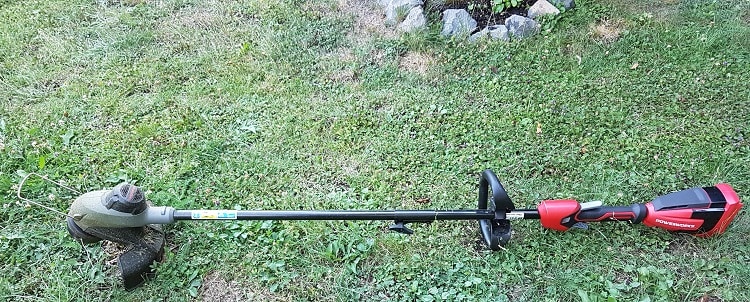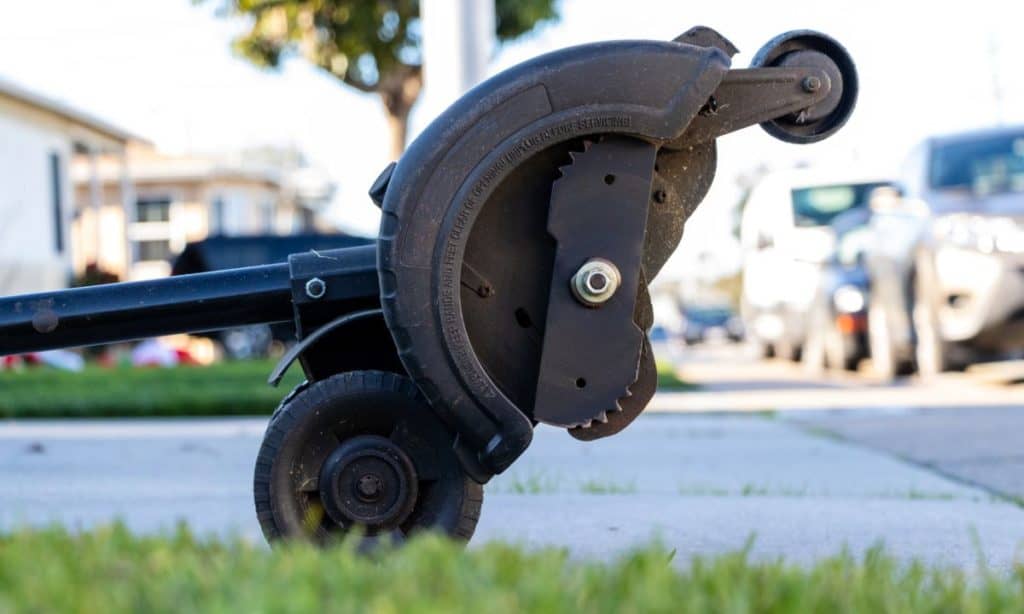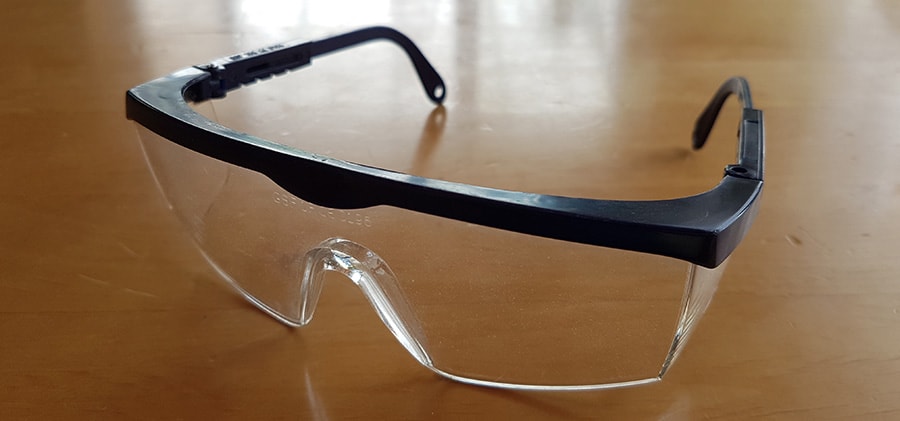When I started caring for my first lawn I wasn’t sure where to start and in what order. Should I edge, or trim, my lawn first? Or should I mow first? Here are my thoughts on it.
You should edge your lawn first, then use a trimmer, then mow. By edging the lawn first, you create less work for yourself and make it easier to maneuver the mower in the yard, ensuring a uniform cut.
You very well may have a different opinion, so let’s take a few moments so you can discover why, if you do hold that different opinion, you are wrong. I mean, you want your lawn to look better than the neighbors’ lawn, right? Well, they might mow first, so you’re off to a good start.
Why Should I Edge My Lawn First?
Edging does more than give your lawn clean lines, although that’s a big part of it.
Edging the lawn before you mow means the lawnmower will suck up some of the clippings left behind by the edger, chop them up, and deposit them in the grass. The wind will also carry some of the clippings away, leading to less clean-up later.
Think about your driveway and front sidewalk, which are the first things you or the people you invite over will see every time you or they show up to your house. If it’s you, it’s nice to come home to a place that looks good.
If it’s company, you don’t want them thinking they’re walking into the jungle.
For this reason, we run an edger along the edges of the lawn to clean them up. Most have a blade on it, so it makes a sharp line—and a nice, vertical one, too, so it looks neat and clean.
Edgers also leave grass clippings on the sidewalk and in the driveway, which is one reason why you should complete this task first. After edging and then using the lawnmower, there will still be clean-up to do.
Why We Mow and Edge our Lawn
If you were at all like I was as a teenager when your dad told you to mow the lawn, you said (or thought, depending on how your dad reacted to your smarm on any given Saturday morning), “But it’s just going to grow back. This is stupid.”
He countered with some dad wisdom like, “So you don’t take a shower just because you’ll need another one tomorrow?” before he left you in the garage to start the lawnmower.
Now that we own our homes, though, we realize there are legitimate reasons to mow regularly.
We want to make sure bugs and critters have a harder time hiding on our property, and we want a nice place for our kids to do their kid stuff in the backyard. Most importantly, we want the place to look nice.
Homeowners Associations aside, this is your home, and you want it to look nice even if you’re not putting it on the market. So we buy lawn care tools and sweat and grunt and spend our weekends keeping it looking lovely.
The Debate
So when it comes time to cut stuff, we’ve all thought to ourselves, “Trimmer, edger, mower—which should I run first?” And we may have experimented, timing ourselves doing the lawn maintenance in different orders trying to find “The Way.”
There is one correct answer: Edge your lawn first, then run the trimmer, and finally, mow the lawn.
Trim The Lawn After Edging
Maybe you call it a weed-whacker, but you know what I’m talking about—the tool with the heavy-duty fishing line that decimates anything organic in its path, including your shin if you don’t pay attention.

We use this around trees and other plants since the lawnmower blade can only get so close to them due to the body of the mower housing the blade.
Doing this before you mow means you can cut an area around the tree or other obstacle, which means you have less maneuvering to do with your mower in trying to make sure every blade of grass near that obstacle gets cut.
It also means you can mow over the cut grass and chop it finely, as you did with the clippings from running the edger.
And here I should mention overgrown lawns. We’ve all had times when we missed our regular mowing window for whatever reason, only to face utter wilderness when we finally got out there to get caught up.
Trimming first means you have a better shot of making sure you don’t have those three extra-tall blades of Bermuda sticking up when you’ve finished mowing. They mock us when they do that.
This same thing applies to edging, and perhaps even more so. When a lawn is overgrown, and the edging has completely gone to pot, that grass growing out into your driveway is rarely tall, so mowing over it won’t do much good in terms of getting rid of it.
Edge first, get a nice, clean line re-established and then get started on trimming and mowing.
Overgrown edges will also yield substantially more grass clippings and soil, which is all the more reason to do some of the cleanup with your lawnmower, which you can’t do if you don’t edge first.
Mow After Edging and Trimming
Once you’ve finished all the edging and trimming, you’ve made it so much easier on yourself now that it’s time to start the lawnmower.
Getting around trees and the rocks you’ve used as a garden border will now be easier, and you won’t miss a blade here and there close to the non-grass elements in your yard.
Also, you’ve got a much better shot at cutting all your grass to one level because when you trimmed, you didn’t scalp the grass but instead left it a little bit taller than where you’ll cut with the mower.
When you mow, you’ll be able to get a nice, level cut to your grass.
Equipment Needed for Mowing, Edging, and Trimming
Among the debates above, we have gas vs. electric options for your trimmer, edger, and mower. Admittedly, electric mowers haven’t become as widespread as the trimmers and edgers, but we’ll get to that in a few paragraphs.
But first: what you want to avoid at all costs is using your trimmer as an edger. I mentioned earlier that a good edger has a blade to it, kind of a mini-me version of the business end of your mower.

This blade is essential because it provides the straight, clean, cut you want for the edges of your yard.
Most trimmers use a line or string, often a thick plastic rope-like line that, when spun at velocity, cuts through grass every bit as mercilessly as a metal blade. However, because it is a string, it’s not stable for the line it cuts.
Many trimmers offer a turning feature that allows the trimmer head to pivot so that the plane the string spins on goes from horizontal for trimming grass to vertical for edging. But this will not provide a clean, straight-up-and-down cut to the edges of your lawn.
So you want a dedicated edger for this job. But gas or electric? Both have their pros and cons, and you’ll make your choice based on what’s best for you.
Gas vs. Electric Edger
Gas engines in lawn care are almost always two-stroke engines that require a special mixture of gas and oil.
They are loud, and they generate a good deal of pollution, but their power is unparalleled. For that reason, many people opt for gasoline engines, embracing the maintenance, oil, gas, fumes, and noise willingly because they get the job done.
Electric motors in lawn care tools are quieter, and while they spin the blades or swing the string around, there’s the question of where the electricity comes from. Either you use an extension cord plugged into an outlet in your garage or whatever, or you have a cordless unit with a rechargeable battery.
With a cord, you have, well, a cord you trail along behind you in the yard. But a battery can be heavy and will eventually run out of power.
Pros of Gas-Powered Engines
- Unparalleled power
- Run time is limited only to the amount of fuel you have on hand.
Cons of Gas-Powered Engines
- Two-stroke engines are some of the worst polluters around, and engine noise can be unhealthy, causing hearing damage and noise pollution.
- A lot of maintenance is needed, from oil to spark plugs to air filters.
Pros of Electric Engines
- They are relatively quiet.
- You have almost zero maintenance.
- Corded models can run indefinitely.
Cons of Electric Engines
- Cordless units are heavy due to battery weight.
- You don’t have as much power compared to gas engines.
- Corded units can be awkward when working around an extension cord.
- Battery-powered units lose their charge before you can finish your lawn.
6 Tips and Tricks for Edging
When you get your tools out of the garage and are ready to do the work, here are some things to keep in mind that will make life a little easier on you.
1. Wear Safety Glasses
The edger, as mentioned already, has a sharp, metal blade that spins at high speeds. That means they can sling yard waste like grass clippings but also twigs and rocks at velocities high enough to hurt you.
Most of us have been hit in the legs by flying debris in this very situation, and it stings. Imagine if you were hit in the eye instead, so always wear safety glasses to avoid injury.

2. Edge on a Schedule
Maybe you don’t want to edge every single week, and perhaps you don’t need to. However, you should edge, at the very least, once a year. If this is your approach, do it after mid-June, which means you’ll be cutting after the grass’s heavy growing season will be done for the year.
If yours is a once-a-week or once-a-month edging yard, stick to that schedule.
3. Use the Pavement Edge
Your edger will have a guide on it, which is a piece of hard plastic or, more likely, metal.
It’s basically a tooth that you stick into the ground to help guide your edger as you cut. It should rest against the concrete next to which you are edging, which means you’ll have to edge in a specific direction. Moving north to south won’t work if the tooth is on the left.
Pay attention to this guide so you can have clean lines. That’s why you’re edging in the first place.
4. Saw Back and Forth
No matter how sharp your blade is, you can’t just hit the gas, or electricity, push the edger from point A to point B, and be done with it. Think “two steps forward, one step back” as you edge. Push the edger a bit, back it up a little, and then move forward again, which will make for a cleaner line. It is critically important if you face really overgrown edges.
5. Don’t Cut Too Deep
Most edgers allow for the adjustment of how deeply the blade cuts. You want to cut about ½” (1.27 cm) lower than the pavement edge. Most edgers reach up to 2” (5.08 cm) deep—and for good reason. Any deeper than that is overkill and will only serve to dull your blade faster.
6. Pay Attention
Even with safety glasses, you still need to be aware of what’s going on around you.
Power tools are inherently dangerous, so you have to watch what you’re doing. The guide on your edger is a great safety feature, but your blade won’t always automatically follow it.
Watch what you’re doing so that you don’t run your edger off course and gouge your lawn.
5 Tips and Tricks for Mowing
After edging, it’s time to mow, and most of us overlook at least one of these. If you want your grass to stay healthy and your lawn to look its best then utilize these tips and tricks the next time you’re doing yard work.
It will make your work easier and your lawn will be the envy of the town.
1. Keep Your Blades Sharp
Do you hate making multiple passes? You have to do that when your blades are dull. Your mower will miss fewer errant blades of grass. Sharper blades also make cleaner cuts and allow the grass to recover more quickly.
The time you spend sharpening your blade will pay off with you spending less time mowing each time.
2. Check the Lawn First
Hitting a rock can be annoying, or it can be catastrophic. Your blade was nice and sharp, and now it’s getting dull. Or worse, it broke on a rock or did some other terrible damage to your expensive new mower.
Take a minute to look over your lawn before you get started. If there’s a piece of debris that can give you fits, the chances are good that you’ll be able to see it sticking up in the yard.
And if you live next to horrible neighbors who love to put rocks and other debris in your yard, doing a thorough walk-through before you mow is critical for your safety and the safety of others. It also means that your house won’t get holes in it from flying debris.
3. Mow your Lawn at the Right Time
More than just saving yourself from overheating, mowing in the morning before it’s too hot allows moisture to stay in the ground after you cut the grass. If the blazing sun is high above when you cut the grass short, any water in the roots will be much more likely to evaporate.
On the other hand, never mow wet grass. If it rained last night, you can’t cut at dawn. You’ll clog up your mower, so you’ll spend as much time mowing as you’ll spend cleaning clumps of grass out of your mower.
4. Don’t Cut the Grass Too Short
It won’t mean you have more time between mowings. Cutting off more than one-third of the blade of grass can damage the rest of the plant. Also, too-short grass lets more moisture rise from the soil, so don’t set your mower to its lowest cutting setting and scrape bald spots in your lawn.
5. Mow in Different Directions
If you fall into a pattern, such as mowing left to right along the back fence, mowing from the front to back in the front yard, or starting from the driveway and moving across to the property line, your grass will learn to lean in those directions.
Mowing along different routes helps your grass stay growing upright. It keeps the lawn healthy and looking lush.
Edgers for Your Consideration
There are many edgers in various configurations available, but I’ve tried to make a broad list of some of the best from all power source options. Like your response to the gas vs. electric debate, what works for you will depend on what you need in your own lawn.
All of these are available through Amazon.com.
WORX WG896 Electric Lawn Edger
This electric unit requires an extension cord, which means it’s light because it does not house a big rechargeable battery. The electric motor spins the unit’s 7.5” (19.05 cm) blade at 4700 rpm, which is pretty fast. The adjustable depth of cut and shaft length make for a versatile edger that’s comfortable to use.
Craftsman Gas Powered Grass Lawn Edger
This gas-powered hoss is pricey, but you’ll get all the clean edges you want with it. The blade is 9” (22.86 cm) long and can cut down almost 2” (5.08 cm) into the ground. That seems a little excessive, but if you need that, well, here it is. Three wheels lend stability to this unit, which is good because this thing is big.
Black + Decker Edger & Trencher
Another plug-in electric edger, this Black + Decker unit, brings enough power that it can also function as a trencher. Adjustable blade depth applies to edging or trenching, making this versatile and really easy to use. Since it plugs in, you’ll never worry about running out of gas or juice, provided you remain in the good graces of your utility company.
Greenworks Cordless String Trimmer/Edger
The one drawback here is the battery runtime, which Greenworks lists at 30 minutes.
However, if you have a small or medium-sized yard, that’s probably more than enough time unless you’re dealing with excessive overgrowth. The head pivots and wields a 13-inch (33.02 cm) string.
While this article discussed not using string trimmers, this product is one exception. Greenworks specifically built this unit to edge with string, which means it has wheels to support it in edging mode and holds the plane of the string steady.
Sources
- All-Terrain Fargo: Edging Your Lawn – The Right Way
- BobVila: How to Mow a Lawn
- DIY Network: 13 Lawn Mowing Tips for a Healthy Lawn
- Down to Earth: Two-stroke vehicles are the worst polluters
- Grounds Guys: Lawn Mowing Tricks No One Ever Told You
- Horticulture Magazine UK: 5 Best Lawn Edging Tools For Neatly Cutting Grass Edging
- Remodelaholic: Lawn Maintenance: Trim and Edge your Yard like a Pro
- The Atlantic: Get Off My Lawn
- Turf Magazine: Trimming and Edging the Right Way
- Turf Magazine: What Comes First: Mow, Edge or Weed?

